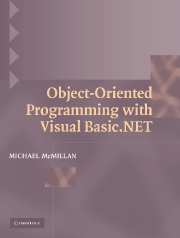Book contents
- Frontmatter
- Contents
- Preface
- Chapter 1 An Overview of the Visual Basic.NET Language
- Chapter 2 An Overview of Object-Oriented Programming
- Chapter 3 Structures
- Chapter 4 Classes
- Chapter 5 Access Modifiers
- Chapter 6 Abstract Classes and Interfaces
- Chapter 7 Implementing the IEnumerable and IComparable Interfaces
- Chapter 8 Designing and Implementing Exception Classes
- Chapter 9 Design Patterns and Refactoring
- Chapter 10 Object Internals: Reflection and Attributes
- Chapter 11 Object Persistence: Serialization
- Chapter 12 Building a Windows Application
- Chapter 13 Database Programming Using ADO.NET
- References
- Index
Chapter 2 - An Overview of Object-Oriented Programming
Published online by Cambridge University Press: 06 July 2010
- Frontmatter
- Contents
- Preface
- Chapter 1 An Overview of the Visual Basic.NET Language
- Chapter 2 An Overview of Object-Oriented Programming
- Chapter 3 Structures
- Chapter 4 Classes
- Chapter 5 Access Modifiers
- Chapter 6 Abstract Classes and Interfaces
- Chapter 7 Implementing the IEnumerable and IComparable Interfaces
- Chapter 8 Designing and Implementing Exception Classes
- Chapter 9 Design Patterns and Refactoring
- Chapter 10 Object Internals: Reflection and Attributes
- Chapter 11 Object Persistence: Serialization
- Chapter 12 Building a Windows Application
- Chapter 13 Database Programming Using ADO.NET
- References
- Index
Summary
Object-oriented programming (OOP) is just one in a series of technologies that has been deemed as the savior of software. In the world of computing, software often gets a bad reputation because so many programs are delivered to the end user late, with significant bugs, and not designed to completely solve the problem the program was written to solve. Object-oriented programming provides a set of tools and techniques to help programmers manage program complexity.
OOP DEFINED
Object-oriented programming is a programming technique that involves structuring a program around special, user-defined data types called classes. Classes are used to break a problem up into a set of objects that interact with each other. A class consists of both the data that define an object and subprograms, called methods, which describe the object's behavior.
A language that is to be called a true OOP language must implement three concepts—encapsulation, polymorphism, and inheritance. Without all three of these features, a programming language can be considered object-based, as Visual Basic 6 is, but all three must be present for the language to be considered a true object-oriented language.
Encapsulation
In the traditional, third-generation programming language (such as earlier versions of Basic, C, and Fortran), all programs consist of two primary elements—program statements and data. The program statements are used to perform operations on the data, but the two elements are always considered to be separate parts of a computer program.
- Type
- Chapter
- Information
- Object-Oriented Programming with Visual Basic.NET , pp. 44 - 63Publisher: Cambridge University PressPrint publication year: 2004



